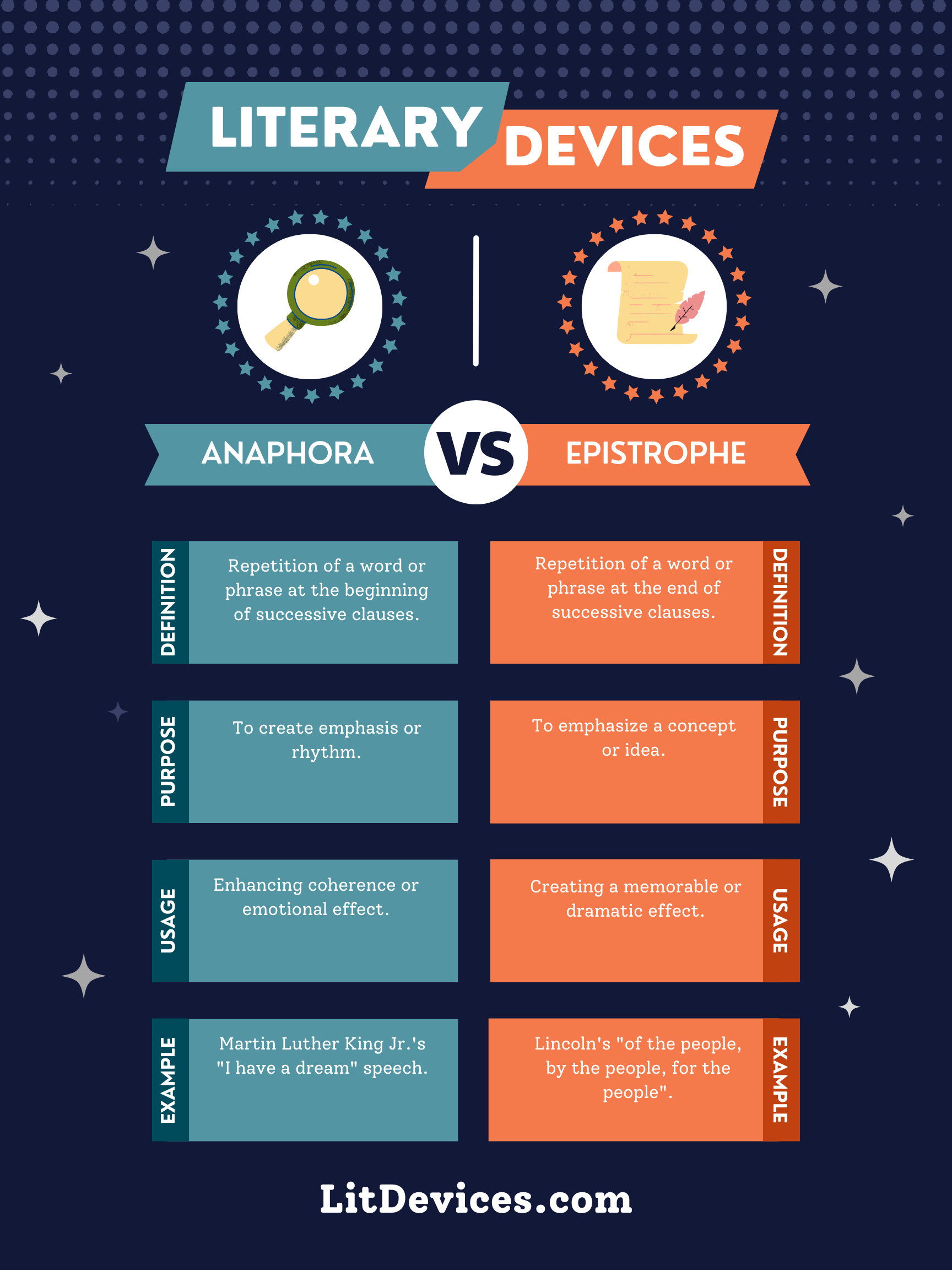Anaphora repeats a word or phrase at the beginning of successive sentences; Epistrophe repeats at the end of successive sentences.
Anaphora
Anaphora involves the repetition of a word or phrase at the beginning of successive clauses or sentences. This device is used to create emphasis, a sense of rhythm, and a powerful emotional effect.
📖 Example: Martin Luther King Jr.’s “I Have a Dream” speech powerfully uses anaphora: “I have a dream that one day…” is repeated at the beginning of successive sentences to emphasize his vision for the future.
Epistrophe
Epistrophe is the counterpart to anaphora, involving the repetition of a word or phrase at the end of successive clauses or sentences. It serves to reinforce a concept or idea, creating a memorable closing to arguments or statements.
📖 Example: In Lyndon B. Johnson’s speech, he repeatedly uses epistrophe: “We shall overcome.” This repetition at the end of sentences emphasizes determination and solidarity.
Summary
| Literary Device | Definition | Purpose | Usage | Relevant Examples |
|---|---|---|---|---|
| Anaphora | Repetition of a word or phrase at the beginning of successive sentences. | To create emphasis, rhythm, and emotional resonance. | Common in speeches, poetry, and prose to strengthen an argument or evoke a response. | Martin Luther King Jr.’s “I Have a Dream” speech. |
| Epistrophe | Repetition of a word or phrase at the end of successive sentences. | To reinforce an idea or concept and create a striking closure. | Often used in rhetoric, poetry, and prose to leave a lasting impression on the audience. | Lyndon B. Johnson’s “We shall overcome” speech. |
Writing Tips
When incorporating anaphora or epistrophe into your writing:
- For Anaphora: Choose your repeated phrase carefully to ensure it aligns with the key message or emotion you wish to convey. The repetition should build momentum and lead to a climactic point in your text.
- For Epistrophe: Use epistrophe to underscore the conclusion of your argument or to reinforce the main theme of your work. The repetition should feel like a natural culmination of your ideas.
🖋 Example for Anaphora: In a poem about perseverance, start each stanza with “In the face of,” followed by different challenges, to emphasize resilience.
🖋 Example for Epistrophe: In an article advocating for environmental protection, end each argument with “…for our planet’s future,” to reinforce the urgency of action.
FAQs
Can anaphora and epistrophe be used together in a text?
Yes, using both can create a symmetrical structure that emphasizes the beginning and end of sentences or paragraphs, enhancing the rhetorical impact.
How do I choose between anaphora and epistrophe?
Consider the effect you want to achieve. Anaphora builds momentum from the start, while epistrophe brings attention to your conclusion. The choice depends on where you want to focus your emphasis.
Is one more effective than the other?
Effectiveness depends on context and purpose. Both can be powerful, but their impact varies based on how they’re used within the narrative or argument.
Exercise
Identify whether the following scenarios use anaphora or epistrophe:
- Every paragraph in a motivational essay begins with “Believe in yourself because…”
- A political speech ends several points with “…for the people.”
- A novel starts numerous sentences with “Under the starry sky…”
- In a closing argument, a lawyer finishes several statements with “…justice for all.”
Answers:
- Anaphora
- Epistrophe
- Anaphora
- Epistrophe
Interesting Literary Device Comparisons
- Metaphor vs. Simile: Both compare two different things to highlight similarities. A metaphor makes a direct comparison (“Life is a journey”), while a simile uses “like” or “as” (“Life is like a journey”).
- Alliteration vs. Assonance: Alliteration repeats consonant sounds at the beginning of words close to each other (“sweet birds sang”), while assonance repeats vowel sounds within words (“I rose and told a tale”).
- Irony vs. Sarcasm: Irony involves stating something that implies the opposite, often subtly. Sarcasm is a form of verbal irony that’s more direct and often used to mock or convey contempt.

